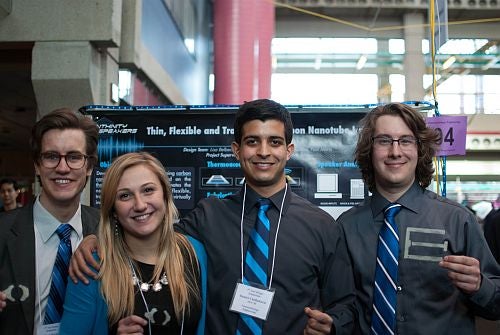On Friday, March 21, 2014, the fifth annual Nanotechnology Engineering Fourth Year Design Symposium was held. This event showcases design projects from the Nanotechnology Engineering program senior class which they work on over the course of three terms. Twenty-one projects in the theme areas of Nano Fluidics and Biotechnology, Nano Electronics and Photonics and Nano Functional Materials were presented by 84 students throughout the day.
The poster presentation competition rewarded four teams:
1st Prize: Alison Lee, Chelsea Marr, Krishna Iyer
Sierra: The Next Generation Biosensor: Our innovative sensor combines fibre optics and LEDs with gold nanoparticles to create a novel biosensor. Our sensor uses the interaction of light around nanoparticles to detect the concentration of certain molecules in a solution. Unlike today’s expensive biosensors, our design offers a versatile product with rapid performance that anyone can use anywhere. It has huge commercial potential in medical diagnostics, drug discovery, and environmental monitoring.
Thank you to our design symposium poster award sponsor, Intlvac.
We had a tie for 2nd place
2nd Prize team 1: Daniel Challadurai, Nolan Lassaline, Paul Morin, Lisa Belbeck
Thin, Flexible and Transparent Carbon Nanotube Loudspeakers: The future of sound technology is here, and it is more flexible than ever. Carbon nanotube speakers generate sound using heat fluctuations, unlike conventional speakers that use moving parts. The advantages are numerous: it is thinner than paper, transparent, and can be bended, twisted and stretched without any changes to the sound. Future applications include curved displays, wearable electronics, and transparent devices.

2nd prize team 2: Madelaine Liddy, Nupur Maheshwari, Wesley Olsen, Hemil Patel
Quantum Aptasensor: Who knew that diamonds were useful for more than just engagement rings? Our group is fabricating a DNA biosensor using aptamers (single stranded DNA) functionalized to a diamond surface, rich with nitrogen vacancy centres for detecting small molecules. The device can optically detect magnetic field changes in the nitrogen vacancy centres of the diamond brought on by the presence of the target molecule. The biosensor features both high sensitivity and specificity towards the target, and is capable of providing an instantaneous detection signal in a unique compact design.
3rd Prize: Lindsay Brock, Ioana Craiciu, Yik Tung Roy Lee, Farzana Yusufali
Greyscale: In the fight to lower energy consumption, a change as small as switching from incandescent to fluorescent light bulbs can make a big difference. In fact, we've already made that transition. So what comes next? Using basic material properties and clever engineering, our team has developed an energy saving roof coating designed specifically for Canadian-like climates. Capable of reflecting or transmitting heat depending on the season, our coating works to reduce the energy required to control room temperature, thereby saving the environment and your money at the same time.